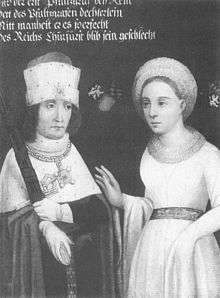Otto II, Duke of Bavaria
| Otto II Wittelsbach, Duke of Bavaria | |
|---|---|
 Portrait from Die Chronik Bayerns | |
| Spouse(s) | Agnes of the Palatinate |
| Noble family | House of Wittelsbach |
| Father | Louis I Wittelsbach, Duke of Bavaria |
| Mother | Ludmilla of Bohemia |
| Born |
7 April 1206 Kelheim |
| Died |
29 November 1253 (aged 47) Landshut |
| Buried | crypt of Scheyern Abbey |

Otto II of Bavaria (German: Otto II der Erlauchte , Herzog von Bayern, Pfalzgraf bei Rhein, 7 April 1206 in Kelheim – 29 November 1253) known as Otto the Illustrious was the Duke of Bavaria and Count Palatine of the Rhine (see Electorate of the Palatinate). He was a son of Louis I and Ludmilla of Bohemia and a member of the Wittelsbach dynasty.
Biography
Otto was born at Kelheim. At the age of sixteen, he was married to Agnes of the Palatinate, a granddaughter of Duke Henry the Lion and Conrad of Hohenstaufen. With this marriage, the Wittelsbach inherited Palatinate and kept it as a Wittelsbach possession until 1918. Since that time also the lion has become a heraldic symbol in the coat of arms for Bavaria and the Palatinate.
He was knighted in 1228 and given the Palatine County of the Rhine by his father, with his seat of power in Heidelberg.[1] With the murder of his father in 1231 Otto also became Duke of Bavaria. There were rumors that the murderer had been bribed by the Hohenstaufen so Otto had a distanced relationship with Emperor Frederick II. His first years of government fulfilled disputes and feuds with the bishops of the country.
During his conflict with Frederick II, Duke of Austria Otto occupied Wels in 1233. This caused the hostility of King Henry who was in rebellion against his father Holy Roman Emperor Frederick II and allied with Frederick of Austria. Otto had to extradite his son Louis as a hostage. But the incident improved his relationship to the emperor who fearing the discontent of the German princes ordered to release Louis. But only in 1241 after a dispute with emperor Frederick II was finally ended, Otto joined the Hohenstaufen party. The previously unsteady Otto then remained true to the Emperor. Reasons were also the threat of the Mongol invasion of Europe and increaseing frictions with Wenceslaus I of Bohemia after the death of Frederick of Austria and suspiciousness against Henry Raspe. Otto's daughter, Elizabeth, was married to Frederick's son Conrad IV in 1246. Because of this, Otto was excommunicated by the pope. He was convinced by Bertold of Regensburg to repent in 1250. But when Otto died in Landshut in 1253 only 12 years later, at the request of the widow and the sons, his body was given an ecclesiastical burial. Pope Clemens declared that the Duke had given unmistakable signs of repentance. Like his forefathers, Otto was buried in the crypt of Scheyern Abbey.
Otto acquired the rich regions of Bogen in 1240, and Andechs and Ortenburg in 1248 as possessions for the Wittelsbach and extended his power base in Bavaria this way. With the county of Bogen the Wittelsbach acquired also the white and blue coloured lozenge flag which since that time has been the flag of Bavaria (and of the Palatinate).
Family and children
Otto married Agnes, the daughter of Henry V, Count Palatine of the Rhine (a son of Henry the Lion) and Agnes of Hohenstaufen, in Worms in 1222. Their children were:
- Louis I, Duke of Upper Bavaria (13 April 1229, Heidelberg – 2 February 1294, Heidelberg).
- Henry I, Duke of Lower Bavaria (19 November 1235, Landshut – 3 February 1290, Burghausen.
- Elisabeth of Bavaria, Queen of Germany (c. 1227, Landshut – 9 October 1273), married to:
- 1246 in Vohburg to Conrad IV of Germany;
- 1259 in Munich to Count Meinhard II of Gorizia-Tyrol, Duke of Carinthia.
- Sophie (1236, Landshut – 9 August 1289, Castle Hirschberg), married 1258 to Count Gerhard IV of Sulzbach and Hirschberg.
- Agnes (c. 1240–c. 1306).
Ancestors
| Ancestors of Otto II, Duke of Bavaria | ||||||||||||||||||||||||||||||||||||||||||||||||||||||||||||||||||||||||||||||||||||||||||||||||||||||||||||||||||||||||||||||||||||||||||||||||||||||||||||||||||||||||||||||||||||||||||||||||||||||||||||||||||||||||||||||||||||||||||||||||||||||||||||||||||||||||||||||||||||||||||||||||||||||||||||||||||||||||||||||||||||||||||||||||||||||||||||||||||||||||||||||||||||||||||||||||||||||||||||||||||||||||||||||||||||||||||||||||||||||||||||||||||||||||||||||||||||||||||||||||||||||||||||||||||||||||||||||||||
|---|---|---|---|---|---|---|---|---|---|---|---|---|---|---|---|---|---|---|---|---|---|---|---|---|---|---|---|---|---|---|---|---|---|---|---|---|---|---|---|---|---|---|---|---|---|---|---|---|---|---|---|---|---|---|---|---|---|---|---|---|---|---|---|---|---|---|---|---|---|---|---|---|---|---|---|---|---|---|---|---|---|---|---|---|---|---|---|---|---|---|---|---|---|---|---|---|---|---|---|---|---|---|---|---|---|---|---|---|---|---|---|---|---|---|---|---|---|---|---|---|---|---|---|---|---|---|---|---|---|---|---|---|---|---|---|---|---|---|---|---|---|---|---|---|---|---|---|---|---|---|---|---|---|---|---|---|---|---|---|---|---|---|---|---|---|---|---|---|---|---|---|---|---|---|---|---|---|---|---|---|---|---|---|---|---|---|---|---|---|---|---|---|---|---|---|---|---|---|---|---|---|---|---|---|---|---|---|---|---|---|---|---|---|---|---|---|---|---|---|---|---|---|---|---|---|---|---|---|---|---|---|---|---|---|---|---|---|---|---|---|---|---|---|---|---|---|---|---|---|---|---|---|---|---|---|---|---|---|---|---|---|---|---|---|---|---|---|---|---|---|---|---|---|---|---|---|---|---|---|---|---|---|---|---|---|---|---|---|---|---|---|---|---|---|---|---|---|---|---|---|---|---|---|---|---|---|---|---|---|---|---|---|---|---|---|---|---|---|---|---|---|---|---|---|---|---|---|---|---|---|---|---|---|---|---|---|---|---|---|---|---|---|---|---|---|---|---|---|---|---|---|---|---|---|---|---|---|---|---|---|---|---|---|---|---|---|---|---|---|---|---|---|---|---|---|---|---|---|---|---|---|---|---|---|---|---|---|---|---|---|---|---|---|---|---|---|---|---|---|---|---|---|---|---|---|---|---|---|---|---|---|---|---|---|---|---|---|---|---|---|---|---|---|---|---|---|---|---|---|---|---|---|---|---|---|---|---|---|---|---|---|---|---|---|---|---|---|---|---|---|---|---|---|---|---|---|---|---|---|---|---|---|---|---|---|---|---|---|---|---|---|---|---|---|---|---|---|---|---|---|---|---|---|---|---|---|---|---|---|---|---|---|---|---|---|---|---|---|---|---|---|---|---|---|---|---|---|---|---|---|---|---|---|---|
| ||||||||||||||||||||||||||||||||||||||||||||||||||||||||||||||||||||||||||||||||||||||||||||||||||||||||||||||||||||||||||||||||||||||||||||||||||||||||||||||||||||||||||||||||||||||||||||||||||||||||||||||||||||||||||||||||||||||||||||||||||||||||||||||||||||||||||||||||||||||||||||||||||||||||||||||||||||||||||||||||||||||||||||||||||||||||||||||||||||||||||||||||||||||||||||||||||||||||||||||||||||||||||||||||||||||||||||||||||||||||||||||||||||||||||||||||||||||||||||||||||||||||||||||||||||||||||||||||||
References
- Citations
- ↑ Orlop, pp. 194
- Bibliography
- Holzfurtner, Ludwig (2005). Die Wittelsbacher: Staat und Dynastie in acht Jahrhunderten (Urban-Taschenbucher). Kohlhammer. ISBN 978-3170181915.
- Hubensteiner, Benno (2013). Bayerische Geschichte. Munich: Rosenheimer Verlagshaus. ISBN 978-3475537561.
- Stevens, John (1706). The History of Bavaria: From the First Ages, to This Present Year.
- Peltzer, Jörg (2013). Die Wittelsbacher und die Kurpfalz im Mittelalter: Eine Erfolgsgeschichte?. Schnell & Steiner. ISBN 978-3795426453.
- Reiss-Engelhorn-Museen, Mannheim (2013). Die Wittelsbacher am Rhein. Die Kurpfalz und Europa: 2 Bände. Schnell & Steiner. ISBN 978-3795426446.
- Schmid, Gregor M. (2014). Die Familie, die Bayern erfand: Das Haus Wittelsbach: Geschichten, Traditionen, Schicksale, Skandale. Munich: Stiebner. ISBN 978-3830710608.
- Vogel, Susanne (2012). Die Wittelsbacher: Herzöge - Kurfürsten - Könige in Bayern von 1180 bis 1918. Biografische Skizzen. Staackmann. ISBN 978-3886752485.
| Otto II, Duke of Bavaria Born: 1206 Died: 1253 | ||
| German royalty | ||
|---|---|---|
| Regnal titles | ||
| Preceded by Louis I |
Duke of Bavaria Count Palatine of the Rhine 1231–1253 |
Succeeded by Louis II and Henry XIII |